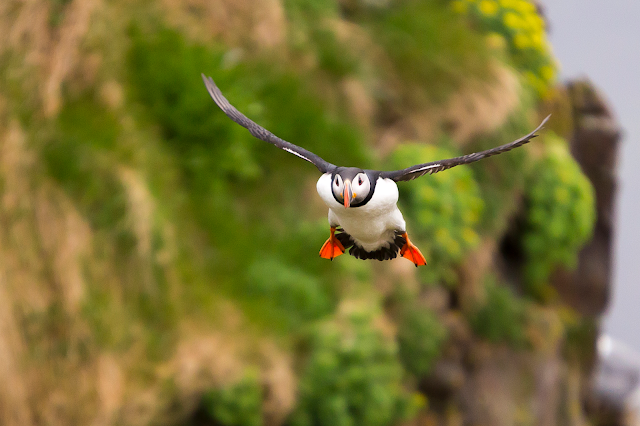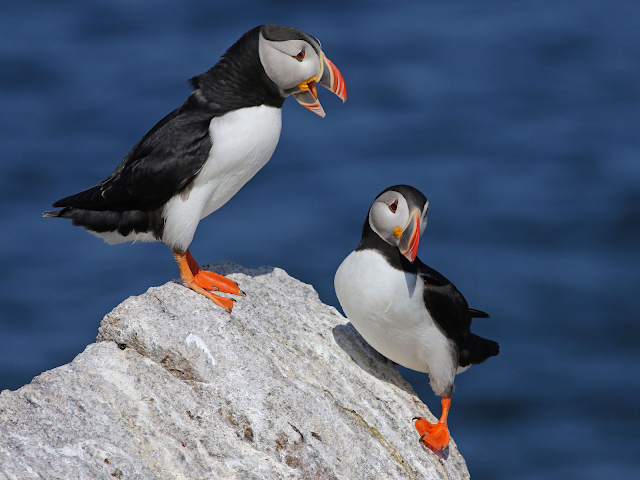The Atlantic puffin (Fratercula arctica) is a small and
tough seabird and the only puffin species native to the Atlantic Ocean. It is
thought to breed in Greenland, North Atlantic islands, Norway, and
Newfoundland. Part of the bill and the legs are completely orange while the
rest of plumage is greyish black to white in color.
Types of Puffins
Depending on which expert you ask, there are three or four
puffin species. All puffin species are types of auks or alcids. The Atlantic or
common puffin (Fratercula arctica) is the only species native to the North
Atlantic. The tufted or crested puffin (Fratercula cirrhata) and the horned
puffin (Fratercula corniculata) live in the North Pacific. The rhinoceros
auklet (Cerorhinca monocerata) is definitely an auk and only sometimes
considered to be a type of puffin. Like the tufted and horned puffin, it ranges
across the North Pacific.
Life History and Reproduction
Little is known about the general breeding biology of the
Atlantic puffin in Svalbard. The single white egg (that occasionally has pale
speckles) is incubated by both sexes for about six weeks.
The nestling, which has a black downy plumage with a white
belly, remains in the nest until it is fully fledged and independent. It is fed
mostly on fish, but also eats some crustaceans and pelagic pteropods. The
fledging period varies from 5–10 weeks depending on the food supply.
The Alantic puffin is sexually mature when it is three or
four years old, but the age at the first breeding is usually between five to
eight years. Adult survival is high, with most estimates of survivorship in the
range of 90–95 %. Thus, many birds reach a considerable age (over 40 years).
Behavior
Atlantic Puffins spend most of their life on the open ocean,
coming ashore only to breed. On land they waddle like a penguin, teetering
slightly from side to side. They "fly" underwater using their wings
for propulsion and their feet as a rudder. They can dive to depths of around
200 feet, but they typically feed in shallower waters. During the breeding
season, they forage in small groups of up to around 7; in the winter they are
less social often foraging singly or with another individual. At the breeding
colonies they are social birds, often placing their nesting burrows within a
couple of body lengths of each other. Birds arriving to the colony often crouch
in a horizontal position with one foot in front of the other as if bowing to be
accepted to the group. They also walk around the colony in a horizontal
position to signal nonaggression. Atlantic Puffins form monogamous bonds and
often return to the same burrow with the same mate in subsequent years. To
attract a female, males flick their heads and grunt like a pig near a nesting
burrow. Once paired, they maintain their bond by rubbing their bills together.
Individuals often shake their head side to side or stomp their feet to proclaim
burrow ownership. Intruding males that get too close to the nesting burrow are
met with ruffled feathers and an open bill. Occasionally a fight ensues with
clawing and grappling. Nonbreeders at the colony often form flocks and spend
hours flying in wide circular or figure-8 paths over the colony cliffs, a
behavior called wheeling flight.
Habitat
Atlantic Puffin is an exclusive marine bird. It breeds on
coastal grassy slopes, but also on sea cliffs, adjacent boulders and
scree-covered slopes. During winter, it ranges in offshore and pelagic
habitats, mainly on deep, icy water. It is rarely seen on land, except for
breeding.
Range
Atlantic Puffin lives
in Northern Atlantic and Arctic, including Greenland, N Canada, Gulf of St
Lawrence, Nova Scotia, Iceland, N Scandinavia, N Russia, Ireland and NW French
coasts.
Diet
Atlantic Puffins feed mostly on small fish such as herring
and in particular sand-eel, which is one of the most important food sources for
many of the world’s sea birds. Because of their specially adapted beak, puffins
are able to go on long fishing trips, storing their previous catch in a neat
row in their beak.
Atlantic Puffins use their tongues to hold the fish against
spines in their palate, leaving their beaks free to open and catch more fish.
This makes each trip much more productive than it would be if they had to ferry
prey back to the burrow each time. Additional components of their diet are
crustaceans and mollusks. A puffin can sometimes have a dozen or more fish in
its beak at once. Atlantic Puffins catch their prey by flying underwater,
diving for around 20 – 40 seconds at a time, using their wings to swim
powerfully down and their webbed feet to point them in the right direction.
Breeding
It takes four to five years before a puffin is mature enough
to breed. Most puffins choose to nest on grassy slopes in burrows 50 to 200 cm
long, which they dig with their bills and the sharp claws on their feet. Some
birds nest in cracks under boulders or in crevices on cliff faces, especially
in arctic colonies where there is little soil or where the soil remains frozen
for much of the summer. After cleaning out their burrows, many puffins line
their nest chamber with grass, twigs, and feathers. The slightly enlarged nest
chamber where the egg is laid is usually placed at the end of the burrow.
Courtship occurs mostly on the water, where males flick
their heads back, puff up their chests, and flutter their wings to attract
females. Billing is one of the most obvious and endearing behaviours to be seen
on a puffin colony. A billing pair face each other and repeatedly tap their
bills together by rapidly swinging their heads side to side. This is usually a
pair-bonding behaviour between mates, but birds will sometimes bill with
neighbours as well.
After a period of courtship and mating, the female puffin
lays a single egg that is about 14 percent of her weight. The egg is whitish at
first with faint blotches, but quickly becomes stained brown with dirt and mud.
Both mates take turns incubating the egg, which takes about six weeks to hatch.
A newly hatched chick is covered with soft down, grey-black on the back and
head and white on the belly, and weighs about 40 g. It has to be brooded, or
kept warm, by a parent for the first week until it can maintain its own body
temperature. Then it is left alone most of the time in the safety of the burrow
while both parents come and go, bringing it food.
The chick grows rapidly if food is abundant. In four or five
weeks it reaches a peak weight of 250 to 350 g and has replaced its downy coat
with body and flight feathers. Chicks normally fledge, or complete the process
of growing flight feathers and leave the nest, when they are about 40 days old,
but the process can take as long as 80 days if food is scarce. Most chicks
fledge under the cover of night and are at sea, far from the colony, by
morning. Many chicks die if food is very scarce. Breeding success varies
greatly between years and even between colonies, but is usually about 60 to 90
percent.
Interesting Facts
- Body of Atlantic puffin is covered with black and white plumage. In the past, feathers of Atlantic puffins were used for decoration of hats.
- Atlantic puffins have very large and colorful beaks (combination of red, yellow and blue colors). Because of their beaks, Atlantic puffins are also known as "sea parrots" or "clowns of the sea".
- Color of the beak changes seasonally. It is pale during the winter and more colorful during the spring, when mating season starts. Birds become more attractive to the opposite sex when their beaks are brightly colored.
- Atlantic puffin is an excellent swimmer. Its webbed feet and strong wings allow fast and precise movement through the water. It can dive 200 feet deep and remain submerged for up to one minute.
- Atlantic puffin is also very fast flyer. It can reach the speed of 55 miles per hour by flapping its wings 400 times per minute.
- Female lays one egg. Incubation period lasts 42 days. Both parents take care of the chick.
- Main predators of Atlantic puffins are black-billed gull and herring gull.
- Atlantic puffins spend majority of their lifetime on the sea. They come to the coast only once per year to reproduce.
- Mating season takes place from April to August. During this period, large colonies of Atlantic puffins gather in their home grounds.
- Atlantic puffins mate for life. They build burrow in the rocky cliffs or on the solid ground between rocks. Burrows are located 3 feet underground.
If You Like, Share with Your Friends :)
source:



















What a pretty bird it is and nice click.
ReplyDeleteACN - Latest News of Japan | Trending News in South Korea | China Business News
The Java Training information's is very helpful to enhance My Technical Skills...Thanks for your valuable information's...Here kind of Information's for you...
ReplyDeleteJava training in chennai | Java training in annanagar | Java training in omr | Java training in porur | Java training in tambaram | Java training in velachery
Your post much attractive. Thats Great, find favorite Lottery of India. Become a winner in 2020 and change your life..
ReplyDeleteKBC Lottery Winner
KBC Lottery Winner 2020 List Today
KBC Lottery Winner 2020 25 Lakh List
KBC Lottery WinnerList 2020
KBC Lottery Winner 2019-20 25 Lakh List
KBC Lottery Number Check
KBC Lottery Number Check Online
Kaun Banega Crorepati Lottery Winner 2020
kbcofficialwinner.com
KBC Official Website
kralbet
ReplyDeletebetpark
tipobet
slot siteleri
kibris bahis siteleri
poker siteleri
bonus veren siteler
mobil ödeme bahis
betmatik
BFQ1V
wefegfegffhgfhgh
ReplyDeleteتسليك مجاري بالقطيف
شركة مكافحة النمل الابيض nuEcNXYMST
ReplyDeleteشركة عزل خزانات بخميس مشيط lMMd933Aas
ReplyDeleteشركة تسليك مجاري بالجبيل 1s6B16l6Vk
ReplyDeleteGood read! Along with learning from blogs like this, training institutes also play an important role. Personally, I found IMMEK Softech
ReplyDeleteto be the best place for AWS and DevOps training, highly recommended
AWS with DevOps Training in Chennai
Google Cloud Platform Training In Chennai
Best Azure Training In Chennai
AWS Training in Chennai
Great post!
ReplyDeleteشركة تنظيف خزانات بالقطيف